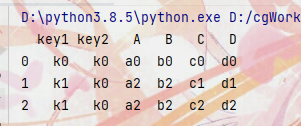pandas画图
# dataFrame画图 plot
"""
kind:
line 折线图 默认
bar 柱状图
barh 横着的柱状图
[barh更多](https://pandas.pydata.org/pandas-docs/stable/reference/api/pandas.DataFrame.plot.barh.html)
hist 直方图
pie 饼图
scatter 散点图
"""
data.plot(kind="line")
plt.show()
# series 画图
data["close"].plot()
plt.show()

文件读取与存储

csv
"""
read_csv
filepath_or_buffer:文件路径
usecols:指定读取的列名,列表形式
"""
data = pd.read_csv(filepath_or_buffer="stock_day.csv", usecols=["close", "open"])
"""
to_csv
path_or_buf: 文件路径
sep: 分隔符,默认用“,”隔开
columns: 选择需要的列索引
header: 是否写进列索引值
index: 是否写进行索引
mode: ‘w’重写 ‘a’追加
index: 是否保存索引
"""
data.to_csv("csvTest.csv",columns=["open","close"],index=True)

HDF5
# HDF5文件的读取和存储需要指定一个键,值为要存储的DataFrame
"""
注意:优先使用HDF5文件存储
HDF5在存储的时候支持压缩,使用的方式是blosc,这是是速度最快,也是pandas默认支持
使用压缩可以提高磁盘利用率,节省空间
HDF5是跨平台的,可以轻松迁移到Hadoop
"""
"""
read_hdf
path_or_buf: 文件路径
key: 读取的键
"""
day_eps = pd.read_hdf("day_close.h5")
print(day_eps)
"""
to_hdf
path_or_buf: 文件路径
key: 保存的键
"""
day_eps.to_hdf("hdfh5.h5",key="day_close")

json
"""
read_json
path_or_buf: 文件路径
lines: 是否按照每行读取json对象 默认false
typ: 指定转换成的对象类型series或者dataframe 默认 frame
orient 数据输出格式
split 将索引总结到索引,列名到列名,数据到数据,三部分分开
records 以columns:values的形式输出
index 以index:{columns:values}的形式输出
columns 以cloumns:{index:values}的形式输出
values 直接输出值
"""
json_data = pd.read_json('Sarcasm_Headlines_Dataset.json', orient="records", lines=True)
print(json_data.head())
"""
to_json
path_or_buf: 文件路径
lines: 是否按照每行存储json对象 默认false
orient 数据存储格式
split 将索引总结到索引,列名到列名,数据到数据,三部分分开
records 以columns:values的形式存储
index 以index:{columns:values}的形式存储
columns 以cloumns:{index:values}的形式存储
values 直接输出值
json_data.to_json("jsonTest.json", lines=True, orient="records")
"""

缺失值处理
move_data = pd.read_csv('IMDB-Movie-Data.csv')
# 判断缺失值NaN isnul notnull
# 存在缺失值,返回false
print(np.all(pd.notnull(move_data)))
# 存在缺失值,返回true
print(np.any(pd.isnull(move_data)))
# 缺失值填充 fillna inplace 是否直接修改原数据
# 按列搜索是否存在缺失值,有则用该列平均值替代
for i in move_data.columns:
if np.any(pd.isnull(move_data[i])):
move_data[i].fillna(move_data[i].mean(), inplace=True)
# 缺失值删除 dropna
dropna_data = move_data.dropna()
# 数据替换 replace
wis = pd.read_csv(
"https://archive.ics.uci.edu/ml/machine-learning-databases/breast-cancer-wisconsin/breast-cancer-wisconsin.data")
"""
注意:读取网络数据可能包证书问题
import ssl
ssl._create_default_https_context = ssl._create_unverified_context
"""
wis = wis.replace(to_replace="?",value=np.nan)
数据离散化
why
连续属性离散化的目的是为了简化数据结构,数据离散化技术可以用来减少给定连续属性值的个数,离散化方法经常作为数据挖掘的工具
what
连续数量的离散化就是在连续属性的值域上,将值域划分为若干个离散的区间,最后用不同的符号或整数值代表落在每个子区间中的属性值
按给定分组次数自动分组
pd.qcut(data,q)
对数据进行分组将数据分组,一般会与value_counts搭配使用,统计每组的个数
series.value_counts() 统计分组次数
data = pd.read_csv("stock_day.csv")
p_change = data["p_change"]
qcut = pd.qcut(p_change, 10)
print(qcut)
print(qcut.value_counts())


自定义区间分组
**pd.cut(data,bins)**
bins = [-100, -7, -5, -3, 0, 3, 5, 7, 100]
p_count = pd.cut(p_change, bins)
print(p_count.value_counts())


one-hot编码
what
把每个类别生成一个布尔列,这些列中只有一列可以为这个样本取值为1,又称为热编码

pd.get_dummies(data,porefix=None)
data:array-like,series,DataFrame
prefix:分组名字
data = pd.read_csv("stock_day.csv")
p_change = data["p_change"]
bins = [-100, -7, -5, -3, 0, 3, 5, 7, 100]
p_count = pd.cut(p_change, bins)
print(pd.get_dummies(p_count, prefix="rise").head())

合并
pd.concat([data1,data2],axis=1)
axis 安装行或列进行合并,0 列合并(默认),1 行合并
concat_one = pd.concat([data, dummies], axis=1)
print(concat_one)


- left: DataFrame
- right: 另一个DataFrame
- on: 指定的共同键
- how: 按照什么方式连接
how SQL Join Name
left LEFT OUT JOIN 左外连接
right RIGHT OUTER JOIN 右外连接
outer FULL OUTER JOIN 外连接
inner INNER JOIN 内连接 默认
left = pd.DataFrame({
'key1': ['k0', 'k0', 'k1', 'k2'],
'key2': ['k0', 'k1', 'k0', 'k1'],
'A': ['a0', 'a1', 'a2', 'a3'],
'B': ['b0', 'b1', 'b2', 'b3']
})
right = pd.DataFrame({
'key1': ['k0', 'k1', 'k1', 'k2'],
'key2': ['k0', 'k0', 'k0', 'k0'],
'C': ['c0', 'c1', 'c2', 'c3'],
'D': ['d0', 'd1', 'd2', 'd3']
})
result = pd.merge(left, right, on=['key1', 'key2'], how='inner')
print(result)

交叉表
用于计算机一列数据对于另外一列数据的分组个数(用于统计分组频率的特色透视表)
# 索引日期转换
time = pd.to_datetime(data.index)
data['week'] = time.weekday
data["p_n"] = np.where(data['p_change'] > 0, 1, 0)
count = pd.crosstab(data['week'], data['p_n'])
print(count)
"""
p_n 0 1
week
0 63 62
1 55 76
2 61 71
3 63 65
4 59 68
"""
#按行求总值
sum = count.sum(axis=1).astype(np.float32)
print(sum)
"""
week
0 125.0
1 131.0
2 132.0
3 128.0
4 127.0
dtype: float32
"""
#求百分占比
ret = count.div(sum, axis=0)
print(ret)
"""
p_n 0 1
week
0 0.504000 0.496000
1 0.419847 0.580153
2 0.462121 0.537879
3 0.492188 0.507812
4 0.464567 0.535433
"""
#画图
ret.plot(kind='bar',stacked=True)
plt.show()

透视表
将原有的DataFrame的列分别作为行索引和列索引,然后对指定的列应用聚集函数
time = pd.to_datetime(data.index)
data['week'] = time.weekday
data["p_n"] = np.where(data['p_change'] > 0, 1, 0)
#省去中间求百分占比
result = data.pivot_table(["p_n"], index="week")
print(result)
"""
p_n
week
0 0.496000
1 0.580153
2 0.537879
3 0.507812
4 0.535433
"""
案例:星巴克零售店铺数据
starbucks = pd.read_csv('directory.csv')
country_count = starbucks.groupby(["Country"]).count()
print(country_count)
country_count['Brand'].plot(kind="bar", figsize=(10, 4))
plt.show()


c_s_count = starbucks.groupby(["Country", "State/Province"]).count()
print(c_s_count)

案例:分析电影
# 06-16 1000部电影
# url = "https://www.kaggle.com/damianpanek/sunday-eda/data"
movie = pd.read_csv("IMDB-Movie-Data.csv")
# print(movie.head())
"""
Rank Title ... Revenue (Millions) Metascore
0 1 Guardians of the Galaxy ... 333.13 76.0
1 2 Prometheus ... 126.46 65.0
2 3 Split ... 138.12 62.0
3 4 Sing ... 270.32 59.0
4 5 Suicide Squad ... 325.02 40.0
"""
# 评分的平均分 6.723199999999999
print(movie['Rating'].mean())
# 导演的人数 644
print(np.unique(movie['Director']).size)
# 获取Rating的分布情况
movie['Rating'].plot(kind="hist")
plt.show()

不准确
# 创建画布
plt.figure(figsize=(16, 4), dpi=100)
# 绘制图形
plt.hist(movie["Rating"].values, bins=20)
# 添加刻度
max_ = movie["Rating"].max()
min_ = movie["Rating"].min()
t1 = np.linspace(min_, max_, num=21)
plt.xticks(t1)
# 添加网格
plt.grid()
# 生成图形
plt.show()

统计电影分类情况-genre
temp_list = [i.split(",") for i in movie['Genre']]
"""
[
['Action', 'Adventure', 'Sci-Fi'],
['Adventure', 'Mystery', 'Sci-Fi'],
['Horror', 'Thriller']
.....
]
"""
genre_list = np.unique([i for j in temp_list for i in j])
"""
['Action', 'Adventure', 'Sci-Fi', 'Adventure', 'Mystery',...]
"""
# 生成全为0的DataFrame
zeros = np.zeros([movie.shape[0], genre_list.shape[0]])
temp_movie = pd.DataFrame(zeros, columns=genre_list)
"""
Action Adventure Animation Biography ... Sport Thriller War Western
0 0.0 0.0 0.0 0.0 ... 0.0 0.0 0.0 0.0
1 0.0 0.0 0.0 0.0 ... 0.0 0.0 0.0 0.0
2 0.0 0.0 0.0 0.0 ... 0.0 0.0 0.0 0.0
"""
# 遍历电影,修改分类列为1
for i in range(1000):
# temp_movie.ix[i, temp_list[i]] = 1
temp_movie.loc[i, temp_list[i]] = 1
"""
Action Adventure Animation Biography ... Sport Thriller War Western
0 1.0 1.0 0.0 0.0 ... 0.0 0.0 0.0 0.0
1 0.0 1.0 0.0 0.0 ... 0.0 0.0 0.0 0.0
"""
sum = temp_movie.sum()
"""
Action 303.0
Adventure 259.0
Animation 49.0
Biography 81.0
"""
genre = temp_movie.sum().sort_values(ascending=False)
"""
Drama 513.0
Action 303.0
Comedy 279.0
Adventure 259.0
"""
genre.plot(kind="bar", colormap="cool", figsize=(10, 8), fontsize=10)
plt.show()























 2704
2704

 被折叠的 条评论
为什么被折叠?
被折叠的 条评论
为什么被折叠?








